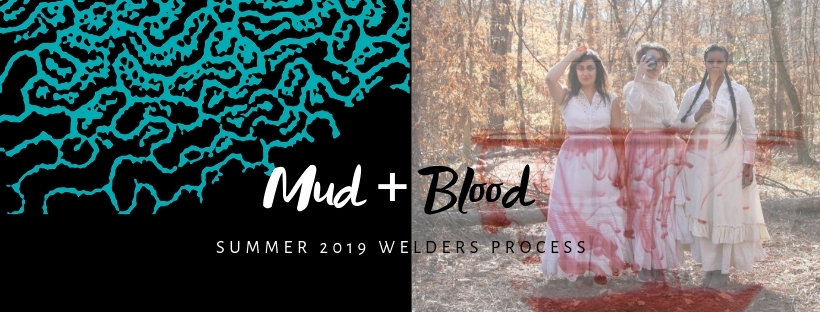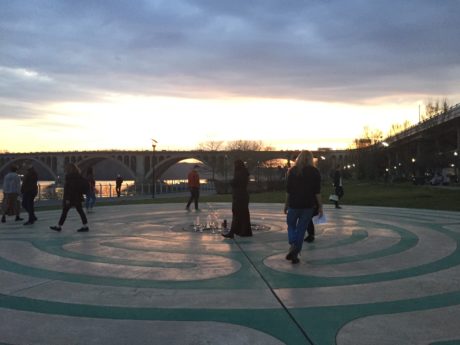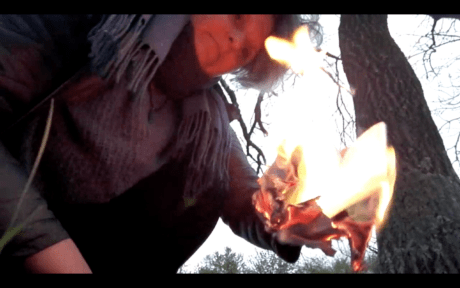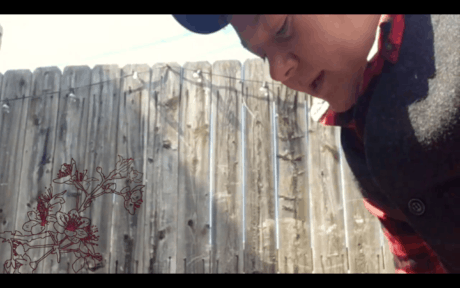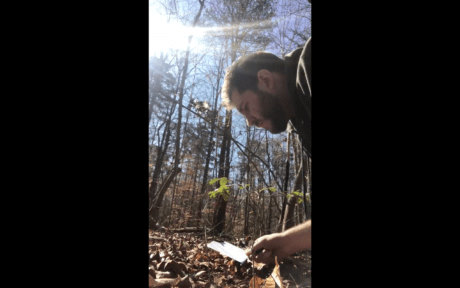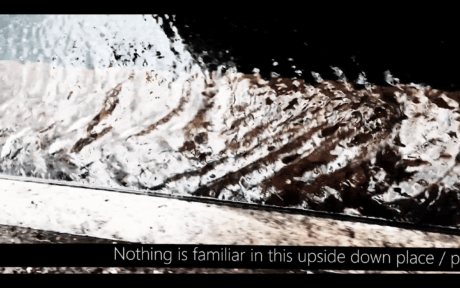Over the next few months, DC Theater Arts will invite guest writers from two Welders projects-in-process to share their creative process with our readers. The Welders, DC’s only dedicated playwrights’ collective, selects a group of playwrights to lead and offers support to help each lead artist realize their vision. The two works being documented here are the final two works of Welder class 2.0. The third class of Welders will take over in January 2020.
Join us here as we document:
- LadyM, a show about witches, violence, and menstruation, being developed by Rachel Hynes, Francesca Chilcote, Anastasia Wilson, and Vanita Kalra.
- the earth, that is sufficient…, an iterative ensemble-created performance series being developed by Annalisa Dias that illuminates the relationship between humans and the earth.
We are excited to offer our readers this special glimpse into the creative process behind these two works.
LadyM will play July 9 – 27 at Joe’s Movement Emporium – 3309 Bunker Hill Road, in Mt. Rainier MD. the earth, that is sufficient… will play throughout 2019, in DC and around the world, www.sufficientearth.com.
Reflections on Peak Bloom: Timing, Temperature, and Transformation
By Hannah Malina
June 20, 2019
DC residents know that every spring, the city will be awash with visitors for the National Cherry Blossom Festival. Whether the cherry blossoms will actually be in bloom is less reliable. Despite the predictions that are made, the cherry blossoms bloom when they’re ready – when they’ve stored sufficient nutrients, when all the conditions surrounding them are right. It’s a foreign concept to those in the theatre world, where we’re used to a schedule that is pre-set – if the show starts at 8:00 on Friday, we begin at 8:00 on Friday, even if our throat hurts and our friends couldn’t come tonight and our performance during Thursday’s rehearsal was so much better.
But what would happen if we created performance based on conditions, rather than calendar? That was the question that prompted Nina Budabin McQuown and DeLesslin “Roo” George Warren to begin the creation of Peak Bloom, a digital performance, or “mushroom,” set within the Welders’ performance project the earth, that is sufficient. Between March 23 and April 23, documentation of the project was nestled within the hashtag #PeakBloom, amongst photos of the cherry blossoms.
I spoke with the creators of Peak Bloom as well as Annalisa Dias, the Welders lead producing playwright behind the earth, that is sufficient, to discuss the process of creating this performance and the things they learned along the way.
Beginning with the concept of timing, Nina said, “We were all thinking about the idea of resources, and one of the first places we began with that is time. Normally we organize a project, a performance, around time, but that’s one of many resources. Plants and fungi go about their own production schedule in which timing is really irrelevant, the question is more about the conditions for blooming or the conditions for sporulating. We were interested in timing our performance off of conditions that were outside of a traditional calendar, and some of the conditions we latched onto were the conditions of hot and cold, when it’s warm and when it’s not warm, and that became our impetus for performance.”
In crafting the ritual itself, the creators took inspiration from existing practices. Roo, who is a citizen of the Catawba Indian Nation (located in what is now known as South Carolina), looked to a ritual from his own community – it was from here that the use of ash, the contrast of cold and warm weather, and, most crucially, the act of saying ‘thanks,’ became central to the ritual. Every detail had a purpose – burying the paper, for instance, was meant to convey a return of the resources extracted to create paper back into the Earth from whence they came. The burning of the poetry illustrated the expending of resources that cannot last forever, that are gone once used up. Nina expressed their difficulty with this detail, as a writer:
“I remember my initial reaction to [the burning], I felt a little worked up! Words are so important! But of course, the importance here doesn’t come from the meaning or delivery of the words but from the giving. It’s a different economy of value, and there’s so many things wrapped up in there.”
Additionally, the performance asked participants to break from the process of constant editing, revisiting their writing only when it was time to complete the ritual’s second phase. “It wasn’t a critical relationship to the words, it was just giving them as they are, and then letting them go, and not looking at them in between. That’s really the first time I’ve been able to do that,” Nina reflected.
But as it turned out, it was the space in between, of leaving the words, that became the biggest challenge, requiring a long-term awareness of weather and our surroundings that many of us have tuned out. In Roo’s words, “I found It really hard to keep remembering to do the piece even though I work outside, because modern society, primarily through the exploitation of nonrenewable resources, has made it so that I can mitigate the effects of weather pretty readily. In a city, for example, I can take public transportation when it’s raining, instead of walking from place to place, I’m gonna put on my warm clothes, turn up the heat in my house. Those are responses that we have built in now, but it’s so different from what our responses would’ve been 100, 200 years ago. We’re creating climate change while attempting to insulate ourselves from the effects of it.”
Annalisa added that the ability to insulate ourselves from the effects of the changing climate is an indicator of our privilege. “There are communities outside of the United States (and within the US, for that matter) where people still rely on firewood or coal power and don’t have the fossil fuel-powered amenities that we have here, so the ways that we insulate ourselves or mitigate the immediate effects of climate change here – those strategies are not necessarily available equitably or evenly across the world. That’s another aspect of Peak Bloom – that it surfaces.”
As we seek a future defined by climate justice, this means recognizing that those who contribute the most to climate change are impacted by it the least. As individuals, then, we can start by exercising our ability to notice changes. In the simple details of Peak Bloom – noticing the temperature, observing its relationship with our inner feelings, accessing a patch of Earth that we are able to use as a ritual space – we are asked to confront the connections between ourselves and our environment that, to many of us, appear to have been severed.
Post Four: What do you mean mushrooms? Phase 1 Reflections
By Annalisa Dias
June 13, 2019
Spring is a season for planting things. For reawakening. For sudden growth. Or, at least this has been true in the landscapes where I grew up: the temperate forests of what is colonially known as North America. But the seasons I have known are changing. And we continue dumping carbon into the atmosphere as though actions have no consequences, as though a fossil fuel economy is inevitable.
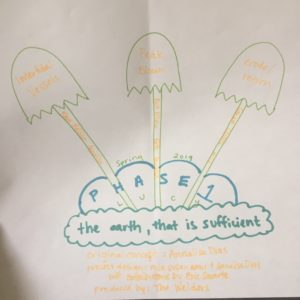
“Spores are hard to pin down, that is their grace.” Anna Lowenhaupt Tsing, The Mushroom at the End of the World. People have been asking me about the mushroom metaphor and what it has to do with theatre and the climate crisis. Why are you calling each performance event a “mushroom”? Wait, so this isn’t a play about mushrooms? Are… you sure you’re not doing mushrooms?
The metaphor is about the ongoing, often unseen process: the relationships among collaborators, artistic visions, communications. All of this we think of as a “mycelial network,” always underground, always transferring chemicals, helping trees and plants communicate with one another. (Seriously, the BBC once referred to this as the Wood Wide Web.) And then, when the conditions are right, a “mushroom” performance emerges. With this work, we’ve been interested in our collective relationship with ecological systems inside of which we live, breathe, and find our meaning. We’re re-evaluating our language of theatrical “production” in favor of relationships; though I’m a playwright, there’s no pre-existing script. (Just like there’s no pre-existing script for how to move forward in the face of the climate crisis.) Still, we’re finding our way together. Even, and especially, when together isn’t always easy.
Here are some of my favorite photos of the Spring Mushrooms.
Intertidal Vessels
Performed at the Georgetown Waterfront Park Labyrinth (March 28 & April 25) on unceded Piscataway lands.
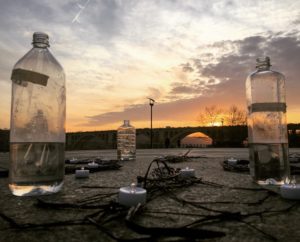
At the March 28th performance of Intertidal Vessels, we started well later than anticipated due to heavy traffic in DC caused by an oil tanker truck overturning on the American Legion bridge. The grim irony was lost on no one.
It did give us the unplanned opportunity to invite audience who had arrived to walk the labyrinth in meditation as we waited for the performance to begin. And this little improvisation based on changing circumstances added what became a very important part of the ritual performance.
Peak Bloom
Performed around the world, hosted online.
My friend and fellow artist Mariae Smiarowska participated in Peak Bloom from the hills of northern England. As it happens, we actually met several years ago in Kerala (India). Her participation had me thinking about the interconnectedness of time and overlapping geographies.
Nina Budabin McQuown’s Bloom, filmed in DC, was a meditation on travel across what is now known as the northwest US. I loved the simplicity of Nina’s ritual in their backyard garden – again surfacing the interconnectedness of memory, time, and landscapes.
DeLesslin George-Warren read his Bloom from the Catawba Indian Nation (in what is now called South Carolina). Peak Bloom still lives online as an ongoing invitation for participation. Please join us from wherever you are.
erode/return
Created on the traditional territories of the Piscataway, xʷməθkwəy̓əm (Musqueam), Skwxwú7mesh (Squamish), Səl̓ílwətaʔɬ/Selilwitulh (Tsleil-Waututh) and Kwikwetlem.
These are stills from the short film created by mia susan amir, Cecilia Cackley, and Sanam Emami.
Their collaboration across a continent made me meditate on the scale of the climate crisis, the kinds of relationships necessary to change systems, and what Anna Lowenhaupt Tsing calls “the art of noticing” in her book The Mushroom at the End of the World. Noticing our relationship with the world around us even as it changes, is an important step toward resilience and connection. These photos capture details of water on its journey over pavement into the abyss of a drain, inviting us to keep wondering where it goes… To what river… to what sea… to what rain cloud… to what human vein…..
Phase 2 of the earth that is sufficient continues with another series of “mushroom” performances in August and September. In the meantime, audiences are invited to collaborate by making a “spore” response. More on how to do that soon….
Post 3: Communal Theatre-making: Using Devised Theatre to Create LadyM
By Elizabeth Morton, Audience Outreach / Dramaturg Intern
June 5, 2019
The company of LadyM is using collective creation to create a holistic and radical approach to the story of Macbeth as well as the stigmatization surrounding menstruation.
When we think of famous and great plays, what typically comes to mind are impactful pieces attributed to one playwright. Plays written by a single person are capable of great things, but can only give one perspective. Even if they showcase multiple viewpoints, these viewpoints are still filtered through the same person. It is impossible to encapsulate the voices of many through single-playwright pieces.
Alternatively, devised theatre hinges on an idea of “collective creation,” which involves a company of creators coming together and constructing a performance from the ground up. Instead of sitting in a room alone writing words on a page, these artists come together to “write performance,” testing and creating moments of theatre with their fellow company members. Devised theatre is well-suited to tell a story that thoroughly explores multiple perspectives or conflicting arguments.
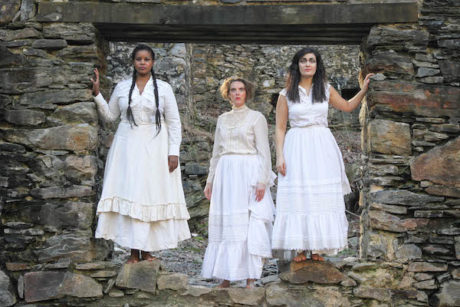
This collective approach to theatre has received some new vocabulary in recent years, but is not a new concept. Collective creation is as old as theatre itself. While we attribute many Greek classics to singular names, it is likely that the dialogue of those plays was heavily influenced by the actors. Commedia dell’Arte developed as a popular form of performance in the 1600s. Many performances were improvisations, based on a set of stock characters that the company and audience alike knew well. Commedia troupes would take these tropes and create a unique performance on the spot using dance, masks, singing, music, and clowning.
Modern devised theatre began in the 1900s, with pockets of directors (at the time, a new profession) in Russia, France, Poland, and Germany experimenting with the concept of “writing performance.” Collective creation burgeoned in the 60s. Activists of the time craved de-centered authority, and the principles of devised theatre were a perfect fit for contemporary political theatre. As devising models became more widespread in the 1980s, their use was increasingly popular outside activist theatre. Devising became a tool that was adopted by a wide range of theatre companies across the globe. Today, there are hundreds of companies that focus solely on devising.
Devising serves political theatre so well due to the ability for multiple artists to respond to source material theatrically. LadyM takes the common experience of menstruation and allows each creator to share their own relationship to it, and to share this through more than just words. LadyM carries on a tradition of reacting to socio-political issues, and also responds to a piece of classic theatre: Macbeth. LadyM deconstructs the characters of Macbeth and interweaves this with the deconstruction of stigma around menstruation.
Want to learn more about devised theatre?
What Is Devised Theatre? – The Theatre Times
Devising Theatre – Drama Resource
Devised Theatre – TDF Theatre Dictionary
The Paradox of Devised Theatre on 21st-Century Stages – HowlRound Theatre Commons
Post 2: Your Iteration Needed
By Hannah Hessel Ratner
May 29, 2019
The creative team behind the earth, that is sufficient shared the last of three pieces of Phase 1 on Friday, May 17. Or, really the last of three “mushrooms” made by the creative collaborators. We will be sharing some additional reflections on Phase 1 but in this post, we want to demonstrate the iterative nature of the project conceived by Annalisa Dias.
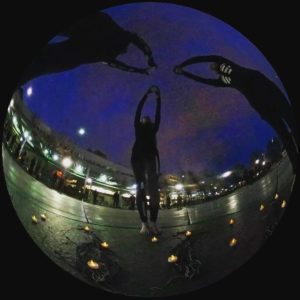
For Phase 1, the collaborators divided into three groups. They started with the same prompt and each group developed separate responses which were released between late March and mid-May
Each of the “mushrooms” involved an invitation to the viewer. Intertidal Vessels, a live performance that took place at the Georgetown Waterfront Labyrinth required some members of the audience to participate in a ritual at the conclusion of the piece. Peak Bloom is a digital event that offers a set of directions for anyone to participate in around the world. And the final “mushroom” of Phase 1, Erode/Return, contains an invitation within it to respond.
The creative team posted this with the video:
We are seeking YOUR responses to erode/return in the form of video, text, audio and image. In your response, share:
- Something that in your lifetime has changed in climate or landscape where you live; and then
- Imagine fifty years into the future. What boundaries or borders have changed or eroded where you live?
Please send your responses to [email protected] by July 1, and they will be posted here alongside erode/return.
And here is where iteration comes in. Iteration is about call and response. It’s about variation. In this process, it comes from the creative collaborators working toward the second phase as a response to the first, but beyond that, it comes from you, from us.
At the core of the earth, that is sufficient is a drive toward hope and regeneration within the climate crisis unfolding before our eyes. Each invitation, each set of directions, each ask is a starting point to think about how you are changed in relation to the art and to the changing world around us.
There are no “correct” responses or predetermined aesthetics. We’re invited to think, reflect, feel, and share. What we share will become part of this ongoing project. You might think of your contribution as“a spore” that will inspire others, lead others to think and act, and this fractal spiral of iterations, calls and responses may contribute to shifting the narrative about the impossibility of dealing with the climate catastrophe. The earth, that is sufficient is rooted in two animating impulses: we already have everything we need, and to change everything, we need everyone. Join us.
More information about the project can be found at www.sufficientearth.com.
Post 1: An Introduction To Mud And Blood
By Welder Hannah Hessel Ratner
May 15, 2019
Welcome to Mud and Blood: A chronicle of theatrical creation leading up to the summer solstice.
It is said that nothing can be certain except death and taxes, but we would like to suggest a more apt version would acknowledge the certainty of mud and blood. In our 21st century life, it is easy to think that we subsist on the digital and mechanical; we seem formed by the representations of ourselves through avatars we create. It’s easy to forget until we are faced with that bleeding cut or a muddy path, it’s easy to ignore the fundamental ingredients that are core to all animal and plant life.
The Welders producing playwright’s collective has two concurrent theater pieces in process that dig their hands deep into the mud and blood that form our lives. This blog tracks the progress of both works. As we head towards the summer solstice and the days reach their peak light, the projects will each be moving towards their next cycles of creation.
LadyM will begin rehearsals in earnest for their performances beginning on July 9. These rehearsals follow two years of devising and development by Rachel Hynes, Francesca Chilcote, Anastasia Wilson, and Vanita Kalra. The piece pits the poetic and sometimes absurdist lives of modern menstruating women against the themes, characters, and language in Shakespeare’s Macbeth to explore blood, ambition, sorcery as power, and violence. Publicly speaking about women and blood these days seems like a necessity as silence had lead to dangerous misconceptions about health, ability and gender and dangerous practices around identity, safety and bodily autonomy.
The iterative performance project the earth, that is sufficient is a contemplative and participatory inquiry into the precarity of human relationships to the extraction, consumption, and power. Producing Playwright and Director Annalisa Dias has brought together a team of transnational artists and makers to approach urgent questions about how we might respond in the face of the climate crisis. The team is wrapping up Phase One of its process this May, which resulted in three “mushroom” performances: Intertidal Vessels, Peak Bloom, and Erode/Return. You can view footage and documentation of that work at www.sufficientearth.com. Phase Two will take place in August & September (locations TBD), and Phase Three will take place in November at the Anacostia Playhouse.
Keep checking back through the remainder of the spring to explore how Welders Rachel Hynes and Annalisa Dias intersect their creative processes with a desire for building hope, climate justice, reproductive justice and above all bringing people together through theater and performance.


